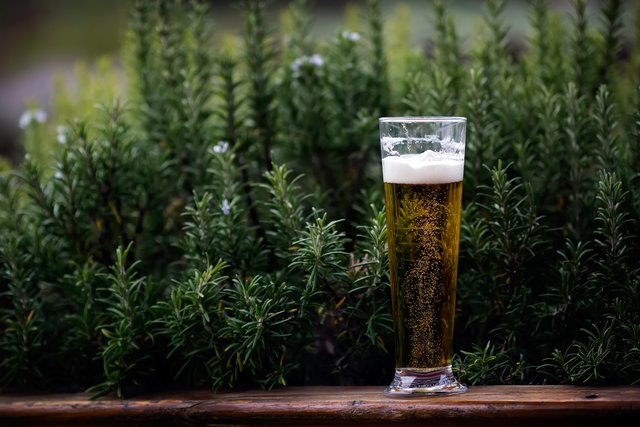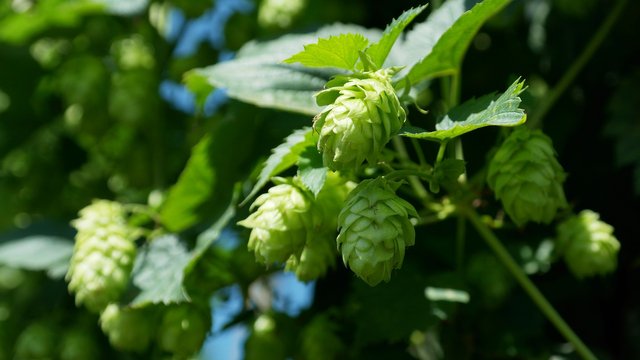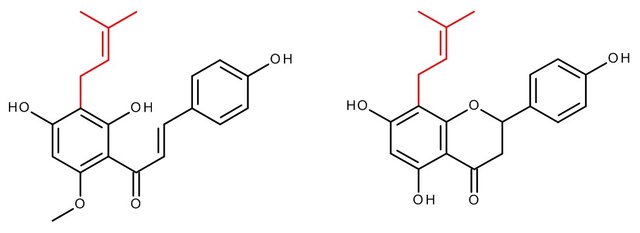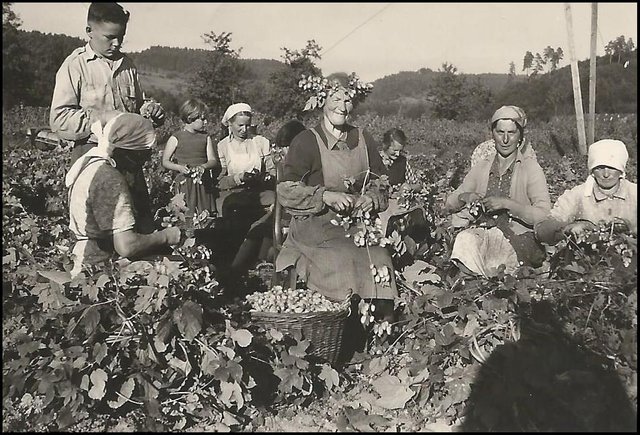Xenoestrogens #4: Hop polyphenols. Is beer consumption messing with our hormone balance?
8-prenyl-naringenin, a compound originating from hops, is the most potent phytoestrogen known today. But how dangerous is it for us?
This post is an english adaption of my recent german post and part of a series on foreign substances that imitate the effect of the female sex hormone estradiol ("xenoestrogens"). I suggest to start with the basics::
Xenoestrogens #1: Natural Estrogens and Estrogen Receptor Signalling
Other posts I wrote on this topic include:
Prelude: Soy isoflavones and the "soy boy" story: 1, 2, 3
#2: Why are some compounds acting as endocrine disruptors, and where do they occur?
#3: Hormones in Plastics

Hmmmmm, beeeer! ~Homer Simpson. CC0, from pexels
Intro
It's not the first time I am writing about hormonal substances (as you can see above), but today is the first time it feels painful.
Here's the thing: I hardly eat soy products, I avoid polycarbonate, I know how (not) to treat canned food and the influence of estrogenic pesticides is strongly regulated in Europe, so that there is actually no danger from this side - at least for a human being. Thus, I could write the problems of other people from a certain distance... so far.
But beer? Ooops, gotcha!
Yes, I am a beer drinker, like so many people in my country. The average Austrian drinks about 100 l of beer every year. And no, this is not light beer. In that regard, we are only surpassed by the Germans and the Czech, who drink an insane ammount of 140 l beer per year - on average!
What's the problem, apart from the alcohol, you ask? Well then...

Hops and its constituents
Since the Middle Ages, the flowers of the hop plant have been used for brewing beer. What was originally a preservative (hops have an antimicrobial effect) is nowadays mainly a bitter aroma component which has become indispensable in beer, and which also is (in German-speaking countries) a mandatory component if a product is to be called "beer" (the "Purity Law" of 1516).

Hop flowers. CC0, from pixabay
In addition to the bitter substances, hops also contain a number of polyphenols, which are generally regarded as beneficial to health due to their anti-oxidative properties. The leading compound of this group is xanthohumol (also abbreviated XAN), a prenylated chalcone. The last 2 words will somehow sound like a mixture of Romanian and Arabic to most of you... But don't despair, the chemist in me is happy for a chance to explain it:

xanthohumol on the right side, its metabolite 8-prenyl-naringenin left.
"Chalcon" means the basic chemical structure in black, "prenylated" means that this basic structure additionally carries a prenyl group (red), which is relatively rare in natural compounds.
Compared to other substances, the prenyl group increases the bioavailability of the substance, as this makes it more lipophilic ("fat-loving") and thus easier for the intestine to absorb it in comparison to other - hydrophilic ("water-loving") - polyphenols.
Great, we have an antioxidant that's also bioavailable. Yay!
Yay?
The trouble is that xanthohumol does not remain xanthohumol. It is "metabolized", i.e. chemically modified, partly already in the plant, partly also during the brewing process. This means that XAN is still present in the finished beer, but the resulting metabolites are of a similar or even higher concentration. One of these newly formed substances is 8-Prenylnaringenin (8-PN), and that one has quite a potential to mess with you. It is the strongest known plant estrogen. Remember the genistein in soybeans? 8-PN is like genistein on steroids.
Which is a hillarious expression in that matter as estrogens ARE steroids. Yeah I know... HILLARIOUS!
/end nerdfactor
Hormone-like effects and their applications
Corresponding to the potency of 8-PN, the effects of hops on our endocrine system can be very strong. As early as the 19th century, it was documented that hop pickers suffered from the hormonal influences of the flowers, the chemical constituents of which they were exposed to in excess. In particular, the activity of 8-PN and similar compounds led to the delay of their mestruation, swelling of the breasts and to other pregnancy-like symptoms.ref1,ref2

German hop harvesters around 1950. Picture licence-free, from here
Nowadays, hops are a popular "medicinal plant" among friends of "natural" medicine. Hop extract has been proven to combat menopausal symptoms, and less serious charlatan... um... businessmen promote hop products for "natural breast enhancement".ref
The fact that the activation of estrogen receptors (ERs) is directly related to an increased breast and ovarian cancer risk in an adverse outcome pathway is seemingly of less importance to them.ref
Bottom lime: Since 8-PN is quite potent in activating both isoforms of the ER, the pseudomedical use of hops should generally be regarded as harmful to health.
And beer?
Ok, all hands on deck. Let's have a look on what that means for beer consumers. Two questions seem important to answer:
How much 8-PN can be found in beer?
The concentrations of 8-PN in beer vary very strongly depending on the beer type, between less than 10 µg/l (most German/Austrian beers, including lager and wheat) up to over 100-200 µg/l (Czech lager, Stout, American Porter).ref
Which amount of 8-PN is needed to cause estrogenic effects?
Here, there's a good and a bad message:
The good one:
In animal experiments, negative effects were only found at doses of about 100 mg (related to human bodyweight)...ref I.e.: If we would apply the usual uncertainty factor of 100 (10 for species extrapolation, 10 for interindividual differences), a dose of 1 mg would be considered the "safe" toxicological limit value.
In other words: According to this, you would have to drink 10 Czech beers a day to get a problem with estrogens.
And with 10 beers a day, 8-PN is your smallest problem, I daresay.
The bad one:
Human studies in menopausal women, who received 100 µg 8-PN daily for several weeks, led to clear changes in the symptoms of menopausal symptoms.
I.e., even at this small dose something seems to happen in humans. 100 µg is still hard to achieve with regular European beers, but 1-2 polyphenol-rich craft beers a day, and you're joining the paty.ref
Conclusion and personal remarks
8-Prenylnaringenin, a metabolite of hops, is of toxic relevance and meets all criteria of an endocrine-disruptor. As a therapeutic plant, hops should only be used with medical advice.
Moderate beer consumption, especially from beers common in Europe, is most likely harmless because the achieved concentrations of the compound are too low to disturb our hormonal balance. Regular consumption of large quantities of beers which contain a lot of hops could be problematic, or at least should be regarded with a certain uncertainty factor, since endocrine effects can be observed in humans at these concentrations - albeit no negative ones.
But chill... We're talking about chronic toxicity! A pale ale every now and then won't kill you.
Disclaimer:
In my blog, I'm stating my honest opinion as a researcher, not less and not more. Sometimes I make errors. Discuss and disagree with me - if you are bringing the better arguments, I might rethink.
Paracelsus (1493–1541)
"All things are poison, and nothing is without poison; only the dose makes a thing not poison."
Paracelsus (1493-1541)
yep, Paracelsus was a wise man. ;-)
Excellent article, covering all bases; one feels in safe hands reading it!
I don't drink much beer or alcohol in general, but I worry whether I'm doing anything from the list of things you said you're not worried about. What's so bad about soy products, for instance? Perhaps you could enlighten us about other hazards in another post!
Also, maybe a little beer isn't harmful, and a little soy isn't harmful either, and the same goes for regulated crops etc. But what if the cumulative influence of all this is harmful?
Hey @alexander.alexis, ty for your comment!
About soy, I wrote already 3 posts (plus a german summary post) that I've linked in the beginning of this post, and I'm not planning on writing a fourth ;-)
Cumulative - or even worse, synergistic - effects are a potential problem, that's absolutely true. Also, it's the very field I am working on in my profession as a scientist. But sadly, little is known today about such combinatory effects. I will dedicate a post to it soon enough though, for it's the perfect topic to end my estrogenicity series.
I guess I should read the fine print!
That's why I can't find a position is Austria... I would ruin the statistics with my beer consumption that measures about 1 liter per lifetime.
no problem, we have a lot of wine too. ;-P
You're looking for a position in Austria?
I was, but no luck :(
well, being specialized is not easy...
In the terms of evolution, specialization is an introduction to extinction.
Currently, I'm planning to return back home.
Congratulations. This post is featured in the nunesso's Curation post for the Nutrition and Natural Products industry. You have received a 100% upvote from us.
https://steemit.com/steempress/@nunesso/nunessonaturalproductscurationpost15-7ydeke51pc
Hello @sco
Thanks for well explained post on the hormone-like chemical constituent of hops that is bound to cause hormonal imbalance when taken beyond certain threshold. If I were women who are prone to this, I would totally avoid beers altogether or considerably limit my intake to twice monthly.
This post is certainly an eye opener and I trust most will find it very helpful.
Regards
@eurogee of @euronation and @steemstem communities
Well as said, moderate consume is not harmful, especially of "normal" beer. Ty for commenting.
Highly educational and, along with your awesome random nerd comments, highly entertaining.
While I agree with you that one Pale Ale won't bother you (unless of course you're gluten intolerant) I make it a point to do my best to avoid all the xenoestrogens as much as possible.
I see it as a better safe than sorry proposition and when you add all the possible ways you can aquire xenoestrogens (soy, plastics, can linings, beer(I didn't know this one), etc) I worry about cumulative effects.
I really enjoy your work! Thank you for the education.
In Peace, Love, and Health
~T
Ah yeah, cumulative effects. A great topic to finalize my series! Ty for reading and commenting!
Nice post, thanks.
I don't drink beer, and with this post probably, I may not ever drink!!
Hi, thanks for commenting, and glad you liked my post.
From the comments I get, I start to think that I might have missed the point a little...
Moderate consumption of "normal" beer is completely fine.
Alright, If you say so.
Great article!
thanks
Test
Well done @sco! You successfully guessed the match result.
Click on the badge to view your Board of Honor.
Do you want to know your current ranking? Read this post
Do not miss the last post from @steemitboard:
SteemitBoard World Cup Contest - Russia vs Croatia
Do you like the SteemitBoard World Cup Contest?
Vote for @steemitboard as a witness and get one more award!